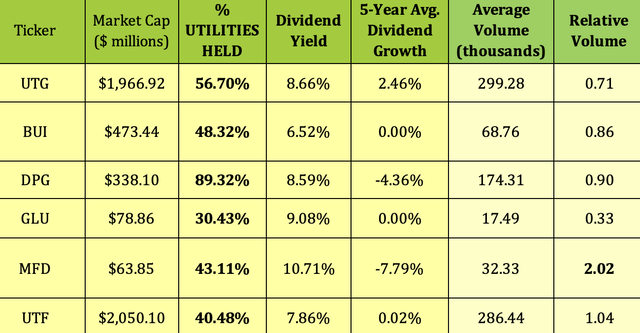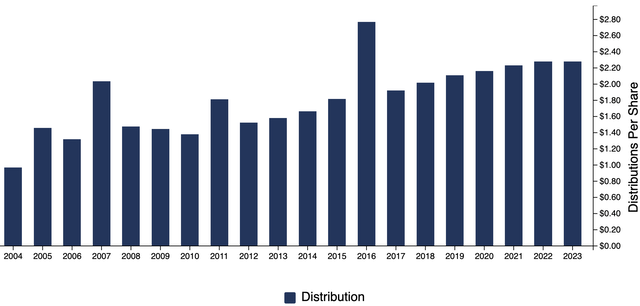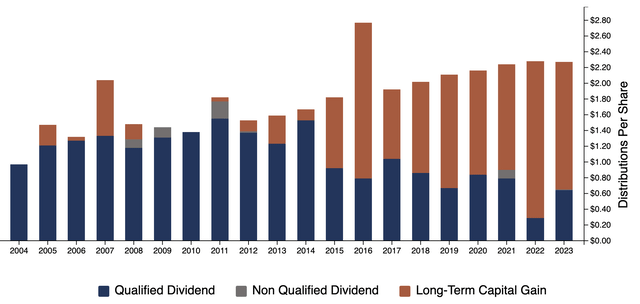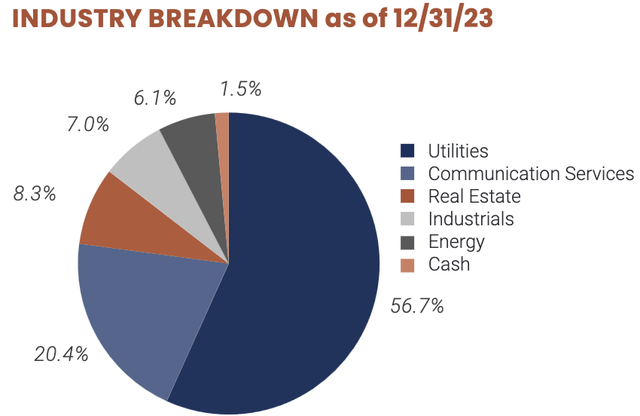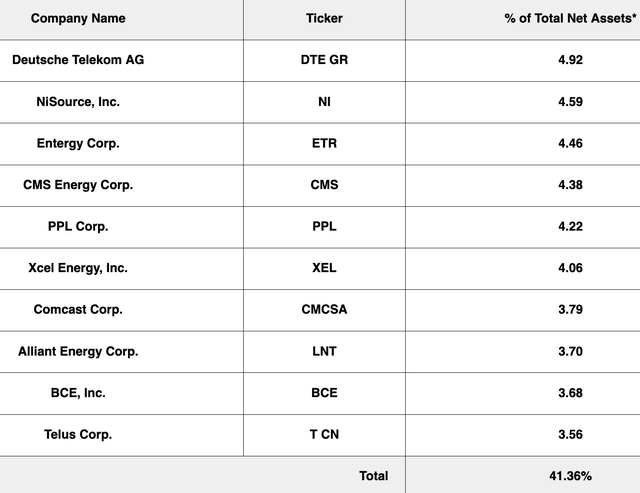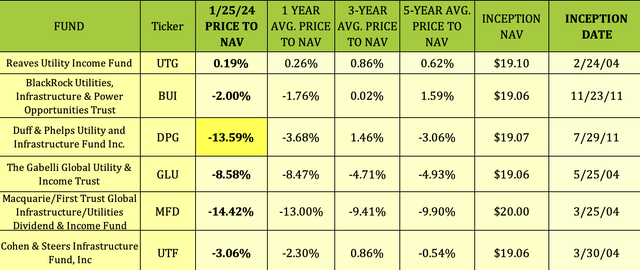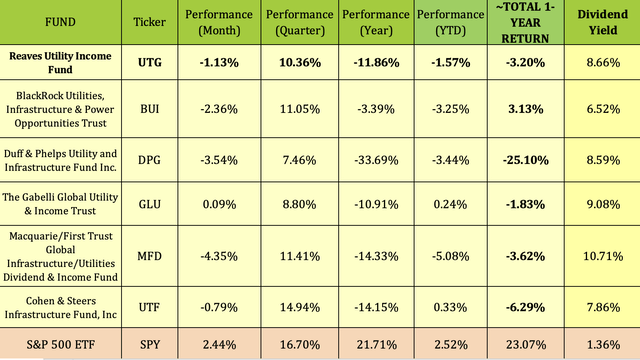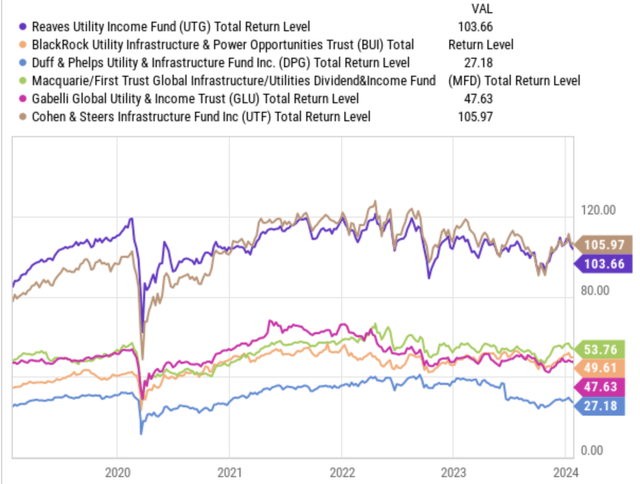shulz
Looking for exposure to the Utilities sector? There are several funds which cover this sector, 6 of which we’ll compare in this article.
Fund Profile
The Reaves Utility Income Fund (NYSE:UTG), is a closed-end fund, a CEF.
UTG’s objective is to provide a high level of after-tax total return consisting primarily of tax-advantaged dividend income and capital appreciation. It intends to invest at least 80% of its total assets in dividend-paying common and preferred stocks and debt instruments of companies within the utility industry. The remaining 20% of its assets may be invested in other securities including stocks, money market instruments and debt instruments, as well as certain derivative instruments in the utility industry or other industries. (UTG site)
As of 12/32/23, UTG had $2.08B in Net Assets, with 65 holdings, up from 44 at 9/30/23. Its expense ratio is 2.44%, which includes 1.10% in Interest expense, due to the 31% leverage that management uses.
The table below compares UTG to some other funds with high exposure to Utilities, including:
-BlackRock Utilities, Infrastructure & Power Opportunities Trust (BUI)-Duff & Phelps Utility and Infrastructure Fund (DPG)-Gabelli Global Utility & Income Trust (GLU)-Macquarie/First Trust Global Infrastructure/Utilities Dividend & Income Fund (MFD)-Cohen & Steers Infrastructure Fund (UTF).
As of 12/31/23, UTG had 56.7% exposure to Utilities, way down vs. 77% at 9/30/23. DPG has the highest Utilities exposure, at 89.3%, while GLU has the lowest, at 30.4%.
UTG is the only fund in this group with a positive 5-year dividend growth, at 2.46%. MFD and DPG actually have negative 5-year growth rates of -.7.79% and -4.36%, respectively.
UTG and UTF have the biggest 3-month average daily volume by far, at 299K and 286K respectively, while GLU is at the low end of the scale, with 17.5K average daily volume.
MFD has by far the highest relative volume at 2X, followed by UTF, at 1.04X, whereas the rest of the group has lower than average relative volume, with GLU having the lowest, at just .33X.
UTG and UTF have the largest market caps of all these funds, at $1.96B and $2B, respectively, with MFD being the smallest, at ~$64M.
MFD has the highest dividend yield of the group, at 10.7%, while BUI’s 6.5% yield is the lowest.
Dividends
UTG has paid out over $1.3B to investors since its inception in 2004.
Management pre-announces each quarters monthly amounts, ex-dividend dates, and pay dates. Management has maintained the monthly payout at $.19 since July 2021, when it was increased from $.18.
At its 1/26/24 closing price of $26.32, UTG yielded 8.66%. It goes ex-dividend next on 2/15/24, with a 2/29/24 pay date.
Taxes
Beginning in 2015, UTG’s distributions started becoming more based on long term capital gains.
In November ’23 – January ’24, UTG’s distributions were comprised of ~78% long term capital gain, and 22% NII:
Holdings
As of 12/31/23, UTG’s 2nd largest industry exposure was 20%, in Communication Services – it holds some big cap telecoms, such as Germany’s Deutsche Telekom, and Canada’s BCE.
Its top 10 includes NiSource, (NI), a US Gas utility, its largest single Utility holding, at 4.59%, with 4%-plus amounts held in other utilities Entergy, CMS, PPL and Xcel. The top 10 holdings comprised 41.36% of its portfolio, as of 12/31/23:
Valuations
CEFs’ daily valuations are calculated at the end of each trading day. Buying CEF’s at deeper than historic discounts to NAV can be a useful strategy, due to mean reversion.
At $26.05, UTG was trading at a slight 0.19% premium to its 1/25/24 NAV per share of $26.00. While that’s somewhat lower than its 1-, 3-, and 5-year price to NAV’s, it’s not as compelling as some of the other current discounts in this group.
At -13.59%, DPG has the biggest deviation from its long term prices to NAV of -3.6% to 1.46%.
MFD’s -14.42% price to NAV is also much deeper than its 3- and 5-year averages, as is GLU’s -8.58% price to NAV.
Performance
Only BUI had a positive total return over the past year, at 3.13%.
However, with the pivot in interest rate forecasts, all of the Utilities-based funds had impressive gains over the past quarter, with UTG rising over 10%, and UTF leading the pack with a ~15% gain. DPG had the smallest price gain, but still rose 7.46%.
As of 12/31/23, UTG’s annual total return from inception was 8.95% on a price basis, and 9.20% on an NAV basis. Its 10-year market price total return was 7.80%, and its NAV return was 6.81%.
Comparing it to these other funds on a total return basis over the past 10 years shows UTG, and its sister fund, UTF, outdistancing the other funds by a wide margin:
Parting Thoughts
Given its long-term performance and attractive yield, UTG could be a good income vehicle for income investors seeking exposure to the Utilities sector. However, we advise waiting for a pullback, with a deeper discount to NAV, before buying.
All tables furnished by Hidden Dividend Stocks Plus, unless otherwise noted.

